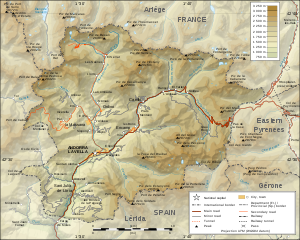
Back Geografie van Andorra AF Xeografía d'Andorra AST География на Андора Bulgarian অ্যান্ডোরা#ভূগোল Bengali/Bangla Geografia d'Andorra Catalan Geografía de Andorra Spanish جغرافیای آندورا FA Andorran maantiede Finnish Géographie de l'Andorre French Andorra földrajza Hungarian
| ||
| Continent | Europe | |
| Subregion | Southwest Europe | |
| Geographic coordinates | 42°30′N 1°30′E / 42.500°N 1.500°E | |
| Area - Total - Water |
Ranked 179th 468 km² 121.4 hectares (1.214 km2)[1] | |
| Coastline | 0 km (landlocked) | |
| Land boundaries | 118 km | |
| Countries bordered | Spain 63 km France 55 km | |
| Highest point | Coma Pedrosa, 2,946 m | |
| Lowest point | Riu Runer, 840 m (2756 ft) | |
| Longest river | Gran Valira | |
| Largest inland body of water | Lake Juclar (23 ha)[1] | |
| Land use | arable land: 1.7% permanent crops: 0% permanent pasture 38.3% forest: 34.0% other: 26.0% (2018) | |
| Irrigated land 0 km2 | ||
| Climate: | temperate; snowy, cold winters and warm, dry summers | |
| Terrain: | rugged mountains and narrow valleys | |
| Natural resources | hydropower, mineral water, timber, iron ore, lead | |
| Natural hazards | avalanches | |
| Environmental issues | deforestation, overgrazing of meadows, air pollution, waste disposal | |
Andorra is a small, landlocked country in southwestern Europe, located in the eastern Pyrenees mountain range and bordered by Spain and France. With an area of 468 km², it is the sixth smallest country in Europe and also the largest of the European microstates.
Andorra consists predominantly of rugged mountains, the highest being the Coma Pedrosa at 2,942 metres (9,652 ft), and the average elevation of Andorra is 1,996 metres (6,549 ft).[2] These are dissected by three narrow valleys in a Y shape that combine into one as the main stream, the Gran Valira river, leaves the country for Spain (at Andorra's lowest point of 840 m or 2,756 ft).
Andorra's climate is similar to that of its neighbours' temperate climates, but its higher elevation means there is, on average, more snow in winter, lower humidity, and it is slightly cooler in summer. There are, on average, 300 days per year of sunshine.
Phytogeographically, Andorra belongs to the Atlantic European province of the Circumboreal Region within the Boreal Kingdom. According to the WWF, the territory of Andorra belongs to the ecoregion of Pyrenees conifer and mixed forests.
Landslides and avalanches are the main natural hazards. There are frequent earthquakes below Richter magnitude 2. There is no historical record of any damaging earthquakes in Andorra, but the Andorran government has studied the possibility of a future one.[3]
In Andorra forest cover is around 34% of the total land area, equivalent to 16,000 hectares (ha) of forest in 2020, which was unchanged from 1990. In 2020, naturally regenerating forest covered 16,000 hectares (ha) and planted forest covered 0 hectares (ha). Of the naturally regenerating forest 0% was reported to be primary forest (consisting of native tree species with no clearly visible indications of human activity) and around 0% of the forest area was found within protected areas.[4][5]
- ^ a b Girard P & Gomez P (2009), Lacs des Pyrénées: Andorre. (in French)
- ^ Atlas of Andorra (1991), Andorran Government. OCLC 801960401. (in Catalan)
- ^ Conseqüències per a Andorra d'un possible terratrèmol Archived 2011-07-06 at the Wayback Machine, Programa dactivitats tardor 08, el Centre Andorra Sostenible, Govern d'Andorra, p.16. (in Catalan)
- ^ Terms and Definitions FRA 2025 Forest Resources Assessment, Working Paper 194. Food and Agriculture Organization of the United Nations. 2023.
- ^ "Global Forest Resources Assessment 2020, Andorra". Food Agriculture Organization of the United Nations.
